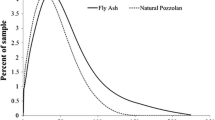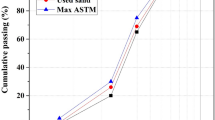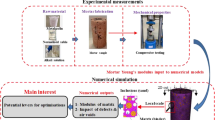Abstract
The geopolymers are a new class of inorganic polymers that are obtained from the alkaline activation of natural minerals or industrial wastes and by-products. In the present investigation we describe the destructive and non-destructive tests carried out on the mortars made from the alkaline activation of the natural pozzolans from the Las Carolinas deposit to measure mechanical and durability properties. For this purpose, sodium hydroxide (NaOH) and sodium silicate (Na2SiO3) were used as alkaline agents. The results were analyzed through an experimental methodology where variables such as alkaline solution and curing time were determined. Finally, the mortars were analyzed mechanically, where their compressive strength was determined at 7 and 28 days of age, and their durability was also evaluated from the measurements of electrical resistivity and ultrasonic pulse velocity. The results obtained were compared with the values specified by the Cuban standard regarding the properties of mortars, also revealed that the pozzolanic material used as source of pure aluminosilicate has low alumina content, which affects the low mechanical resistance of the mortars The final product presents a series of properties that demonstrate the potential of natural pozzolans as a cementing material, which does not have any type of industrial process, or additives, or CO2 emissions during its use, the main reason for this research.
Access provided by Autonomous University of Puebla. Download conference paper PDF
Similar content being viewed by others
1 Introduction
Portland cement, is the undeniable result of the historical development of humanity, today is the most used material after water [1]; its production, except the last two years, is been keeping ascendant [2]. Its use in practically all construction works, its relatively low cost, the possibility of its massive industrial production and the good results obtained in its applications have been the reason why this binder has displaced all those who preceded it, who have been relegated to minor applications in masonry work. Paradoxically, it has also turned out to be one of the main responsible for the environmental degradation of the planet because its production process is fundamentally based on the intensive exploitation of non-renewable resources (raw materials and fuels) and the emission of significant volumes of greenhouse gases [3].
The development and economic growth of the construction industry has promoted a deep interest in the production and valuation of materials of lower environmental impact, economically competitive and with performances equivalent to or even superior to traditional materials. Geopolymers can serve as an alternative to cover environmental, technical and economic problems and promote sustainable development of building materials.
The term geopolymer was coined by Joseph Davidovits [4] in the decade of the 1980s to designate inorganic synthetic polymers of aluminosilicates that come from the chemical reaction known as geopolymerization. The geopolymers have a high potential to be used in many fields, but the use as substitutes for portland cement predominates, field in which most of the research has been directed. These upstarts have the advantage of emitting low CO2 contents during their production, great chemical and thermal resistance, and good mechanical properties, both at room temperature and at extreme temperatures.
In this sense, the factors that intervene in the properties of the final product have been identified, being the physicochemical characteristics and dosage criteria of the raw materials the most relevant parameters. Among the precursor raw materials (source of aluminosilicate) used to activate alkaline are the natural pozzolans, which are basically composed of silica and alumina oxide [5], and in general, their vitreous nature makes them suitable for be activated alkaline.
Our country is characterized by the abundance of resources identified from natural pozzolans, since it has more than 300 million tons of this material with less than 70% zeolitization [6]. At the moment four deposits are exploited (Castilla-La Pita, Piojillo-Tasajeras, El Chorrillo and San Andrés) for their benefit and others that are used for the manufacture of cement (Los Congos, Las Carolinas, Siguaney, Las Margaritas-El Rubio and Palmarito del Cauto) [7]. The subject is novel and encouraging since it has the basic resources to induce the development of geopolitical mortar production for construction from our natural pozzolans. The investigation starts from using as a precursor (source of aluminosilicate) the natural pozzolans from the Las Carolinas deposit, located in the municipality of Cienfuegos, to manufacture geopolitical mortars without using the CPO, which improves its environmental profile and contributes to the sustainable development of the national industry of construction materials.
2 Materials and Methods
In the investigation, a natural pozzolan was used as a precursor, located approximately 12 km northwest of the municipality of Cienfuegos. The deposit is known by the name Las Carolinas, and the alterations observed are zeolitization, sericitisation, argilation and carbonization. It predominates, in more than 90%, the clinoptilolite and mordenite minerals, in addition, it is accompanied by quartz, montmorillonite and chlorite [7]. The characterization of this material is shown in Tables 1 and 2, where the main components are silica and alumina in a ratio of 4.76 times.
The aggregates used in the study are of natural origin, from the La Molina quarry, located in the Mariel municipality, in the province of Artemisa. The tests were carried out according to the Cuban norms NC 186; 181; 177 and 182, all of the year 2002. The fine aggregate fineness module is 3.58; Tables 3 shows its main physical properties.
The presentation of the NaOH used to make the alkaline solution is in the form of flakes with a purity of the order of 98%, and is used in the Dairy Company for the cleaning of pipes once the process of making ice cream, cheese and yogurt is completed. The Na2SiO3 was supplied by the company Electroquímica de Sagua, in Villa Clara, and its composition is shown in Table 4. For the alkaline solution, a NaOH solution with a molarity of 10, and another of NaOH and Na2SiO3 with a molarity of 10 was used and with relation Na2SiO3/NaOH of 0.4.
2.1 Experimental Method
The objective of the investigation is to know the influence of the curing time and the type of alkaline activating solution on the response variables (bulk density, electrical resistivity, ultrasonic pulse velocity and compression strength). The tests to be carried out are based on the methodology, within our reach, proposed by the bibliography used to carry out the research. To infer statistically in the results obtained during the work carried out, a 2k factorial design was considered in which two factors with two levels each will be taken into account.
The factors to be studied during the investigation are the curing time and the activating solution, and they will be measured numerically and categorically, respectively. The curing time has two levels (10 and 28 days) and the activating solution two others (sodium hydroxide and sodium hydroxide and sodium silicate).
2.2 Procedure Description
For the dosage, a Type V masonry mortar was considered in accordance with the Cuban standard (NC-175, 2002), which specifies the properties of the mortars according to the need and proposes the quantity of mortar materials for it. In the case in question the dosage in weight of the cement is the following: a part of cement, three parts of fine aggregate and a part of hydrate of lime.
The amount of water is a function of the required settlement. For the investigation a consistency was conceived in the range of 18–20 cm. During the realization of the test mixtures it was perceived that, for the amount of materials proposed by the Cuban standard and without the use of chemical additives, a stony mortar is obtained. In order to correct this situation, it was decided to use less amount of fine aggregate, so the final dosage was as follows: one part of cement, 2.5 parts of fine aggregate. The amount of materials to be used for each type of mortar is shown in Table 5.
The curing of the mortars was carried out in the stove at a temperature similar to the climate of our country. For this, the temperature was set in the range between 35 and 40 °C, where the mortars were introduced once they were demolded after the first 24 h.
3 Results and Discussion
Among the objectives of the research is the need to determine the influence of the alkaline solution and the curing time on the response variables, which are: density in hardened state, electrical resistivity (ER), ultrasonic pulse velocity (UPV) and compressive strength (CS). To do this, mortars of 4 × 4 × 16 cm were manufactured and tested according to the methodology established in the standards and techniques [8].
Figure 1 shows the analysis of the standardized effects performed from the StatGraphics Centurion XV software [9]. In it is reflected as in the case of the density in hardened state the time factor cured has a negative effect on the results, however, in the case of the ER and the UPV the same factor positively influences the results obtained. The values of CS are conditioned by the alkaline solution, logically, this factor and the amount of aluminosilicates give rise to the formation of polymer chains once the ions are reoriented in solution, therefore, the hardness of the mortar is influenced, among other factors, for the quality of it.
3.1 Analysis of the Hardened State Bulk Density
It was determined that there is a tendency to decrease the density of mortars over time, although in those where the alkaline solution contains sodium silicate the values are slightly higher than mortars where the alkaline solution contains only sodium hydroxide. This is because, as the curing was carried out in the stove at a temperature between 35 and 40 °C, all the extra water used to improve the workability of the mortar evaporated, hence the decrease in the densities of the mortars.
3.2 Analysis of the Ultrasonic Pulse Velocity
The ultrasonic pulse velocity (VPU) values obtained were very low, furthermore, during the tests it was perceived that the receiver recognized between 5 and 10% of the wave emitted by the transducer. According to the RED DURAR [10] and based on a hypothesis test, where a VPU of 2000 m/s was taken as a null hypothesis, it was determined that in all cases the quality of the mortar is “poor”.
3.3 Analysis of Electrical Resistivity
The test was performed on mortars cured at 10 and 28 days. Taking into account that the propagation of the current is through the water contained in the pores and empty spaces inside the concrete, the measurements were made after being wetted. Figures 2 and 3 show the values obtained during the lab work.
According to the TC-154 of the RILEM (Polder et al., 2000), the RE values show a mortar with a risk of “moderate” corrosion. However, it is noteworthy that with the passage of time the values of RE tend to increase. Mortars made from alkaline solution based on sodium hydroxide have higher values compared to the alkaline solution of sodium hydroxide and silicate.
3.4 Analysis of the Compressive Strength
The results obtained at the different ages evaluated and the different solutions are shown in Figs. 4 and 5. In addition, the results obtained were compared, based on a hypothesis test, with the value specified by the Cuban standard for mortars (NC 175, 2002), which is 2.4 MPa (Type I mortar).
To consummate the comparison from a hypothesis test, the equality of the CS value of 2.4 MPa for a Type I mortar was defined as null and, as an alternative, that all the CS values are unequal at 2.4 MPa. In this case, the P-value is greater than 0.05, so the null hypothesis is accepted, which raises the equality between the CS values between the geopolymeric mortars tested and those specified by the Cuban standard for Type I mortars.
3.5 Comparison Between Alkaline Solutions
With the intention of knowing if geopolymeric mortars can be manufactured from the natural pozzolans with the materials available to us, simple comparisons were made between the data obtained from the activated mortars based on an alkaline solution with sodium hydroxide and sodium hydroxide and a part of sodium silicate. As it was conceived from the design phase of the experiment, the type of pozzolan, the concentration of the alkaline solution and the fine aggregate used were kept constant in order to rule out variables that could influence the final result.
In all cases (bulk density in hardened state, ER, UPV and CS) comparisons were made from hypothesis tests, where the approach of the test is as follows:
-
Null hypothesis (Ho): mean 1 (Na) = mean 2 (Si_Na)
-
Alternative hypothesis (H1): mean 1 (Na) > mean 2 (Si_Na)
All in order to demonstrate whether the replacement of a part of the sodium hydroxide used by sodium silicate influences the yields that were measured in the course of the investigation. The docima raised by the software shows that the density in hardened state and the VPU of the mortars made with the alkaline solution containing part of sodium silicate are greater than that of the mortars made with the alkaline solution that only contains sodium hydroxide, and in the case of RE and RC, the opposite happens.
4 Conclusions
-
As a first experience in the manufacture of geopolymeric mortars, it is not possible to define whether the precursor (natural pozzolan from the Las Carolinas deposit) is suitable for the manufacture of this type of mortar, as the influence of the fine aggregate content employed is unknown. and its fineness, the concentration of the alkaline activator and the curing temperature.
-
According to the results of ER and the statistical analysis, the influence of the curing time on the response variables can be inferred, although both factors influence the ER measurements. In addition, it was found that with the curing time the values tend to increase, and from the simple comparison between the data of the response variable it was shown that the values of ER taken in the geopolymer mortars activated with the sodium hydroxide solution they are greater than those activated with the solution of sodium hydroxide and sodium silicate with a 95% reliability.
-
Both, the curing time and the type of alkaline solution influence the CS, however, the interaction between them does not. Logically, the curing time influences more than the type of alkaline solution, in addition, according to the bibliography reviewed for the realization of the present study and the results obtained, it was demonstrated that the sodium silicate used to catalyze the mortar hardening process It is not adequate, because as the main characteristic, this compound is not reactive.
-
The Si ratio: Al = 4.76 which presents the material used as a precursor (natural pozzolan) is much higher than the one recommended by the international bibliography, which must be less than two. This element directly influenced that the results obtained of resistance to compression were only similar to those specified by the Cuban standard for masonry mortars.
References
Aitcin, P.-C.: Cements of yesterday and today concrete of tomorrow. Cem. Concr. Res. 30, 11 (2000)
WBCSD-Cement. Cement sustainability initiative, Getting the numbers right (GNR). Available from: http://www.wbcsdcement.org/GNR-2016/world (2016)
García, I.G., et al.: Estudio del efecto sumidero de CO2 de los materiales de base cemento. Revista Técnica Cemento-Hormigón 939, 14 (2010)
Davidovits, J.: Properties of geopolymer cement. In: Proceeding 1 International Conference on Alkali Cements and Concretes. Kiev-Ucrania (1994)
Malhotra, V.M., Mehta, P.K.: Pozzolanic and cementituos materials. In: Malhotra, V.M. (ed.) Advances in Concrete Technology, vol. 3, p. 191. British Library Cataloguing, 1075 AW Amsterdam, The Netherlands (1996)
Batista, R., et al.: Valoración del potencial de las rocas y minerales industriales para el desarrollo municipal en la República de Cuba. First ed., p. 249 Centro nacional de información geológica, La Habana (2011)
Rodríguez, G., Brito-Rojas, A., Coutín-Correa, D.: Sedimentary zeolite deposits in Cuba. In: Zeolites, p. 13. International Zeolite Association, I.Z. Association, Editor, La Habana (2014)
NC-EN-1015-10. Mortero de albañilería. Determinación de la densidad aparente en seco del mortero endurecido. Oficina Nacional de Normalización, La Habana (2008)
Polhemus, N.W.: Statistical analysis using StatGraphics Plus. In: Quality Control and Experimental Design. S.G. Corporation, Editor, Englewood Cliffs, NJ (1999)
RED-DURAR. Manual de inspección, evaluación y diagnóstico de corrosión en estructuras de hormigón armado, p. 208 (2000)
Acknowledgements
The authors wish to thank the investigation done by the recently graduated Ing. Dayanis Gorina Perdomo during the realization of her thesis, and the help provided by the technicians of the CECAT laboratory.
Author information
Authors and Affiliations
Corresponding author
Editor information
Editors and Affiliations
Rights and permissions
Copyright information
© 2020 RILEM
About this paper
Cite this paper
Ricardo, J.R.C., Gonzales, R.B. (2020). First Experiences with Geopolymeric Mortars of Alkaline Activation Based on Natural Pozzolans. In: Martirena-Hernandez, J., Alujas-Díaz, A., Amador-Hernandez, M. (eds) Proceedings of the International Conference of Sustainable Production and Use of Cement and Concrete. RILEM Bookseries, vol 22. Springer, Cham. https://doi.org/10.1007/978-3-030-22034-1_12
Download citation
DOI: https://doi.org/10.1007/978-3-030-22034-1_12
Published:
Publisher Name: Springer, Cham
Print ISBN: 978-3-030-22033-4
Online ISBN: 978-3-030-22034-1
eBook Packages: EngineeringEngineering (R0)









